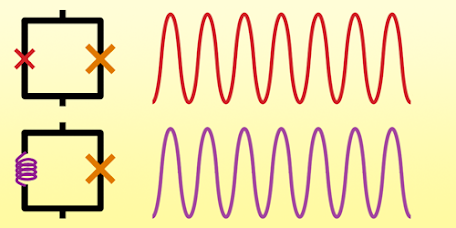The graphene multilayer’s kinetic inductance is both high and tunable, making it a promising material for quantum technologies.

Graphene-based superconductors are a class of materials with many superconducting phases, all of which are tunable by an electric field. One of the hallmarks of superconductivity is kinetic inductance, which quantifies the material’s tendency to oppose a change in current and which arises from the inertia of charge carriers. Rounak Jha at the University of Basel, Switzerland, and his colleagues now report the measurement of tunable kinetic inductance in so-called magic-angle twisted trilayer graphene. Furthermore, they find that this kinetic inductance can be unusually large, making trilayer graphene a promising prospect for superconducting quantum computers and quantum sensors.
The researchers built a superconducting quantum interference device consisting of a loop of superconducting molybdenum-rhenium interrupted by two “weak links” of twisted trilayer graphene. They applied electrical potentials to electrodes above and below the graphene and mapped the change in resistance in the weak links. This procedure pinpointed the temperature and voltage at which the trilayers become superconducting and determined their critical current. Analyzing how this critical current changes in response to a magnetic field for various applied voltages gave the kinetic inductance, which is inversely proportional to the critical current density. These measurements showed that the kinetic inductance can be tuned by altering the field applied via the electrodes and that it can reach 150 nanohenries per square (the units used to quantify thin-film kinetic inductance), 2 orders of magnitude larger than that of commonly used superconductors.
Although trilayer graphene is likely to be harder to scale up than those other materials, the researchers say that it may complement currently available elements and lead to novel superconducting circuits.
#HighEnergyPhysics#ParticlePhysics#QuantumPhysics#AstroparticlePhysics#ColliderPhysics#HiggsBoson#LHC#QuantumFieldTheory#NeutrinoPhysics#PhysicsResearch#ComputationalScience#DataScience#ScientificComputing#NumericalMethods#HighPerformanceComputing#MachineLearningInScience#BigData#AlgorithmDevelopment#SimulationScience#ParallelComputing
Visit Our Website : hep-conferences.sciencefather.com
Nomination Link :hep-conferences.sciencefather.com/award-nomination/?ecategory=Awards&rcategory=Awardee
Registration Link : hep-conferences.sciencefather.com/award-registration/
Member Link : hep-conferences.sciencefather.com/conference-membership/?ecategory=Membership&rcategory=Member
Awards-Winners : hep-conferences.sciencefather.com/awards-winners/
For Enquiries: physicsqueries@sciencefather.com
Get Connected Here:
==================
Social Media Link
Twitter : x.com/Psciencefather
Pinterest : in.pinterest.com/physicsresearchorganisation
Blog : physicscience23.blogspot.com
Instagram : www.instagram.com/victoriaanisa1
YouTube :www.youtube.com/channel/UCzqmZ9z40uRjiPSr9XdEwMA
Tumblr : https://www.tumblr.com/blog/hepcs

Graphene-based superconductors are a class of materials with many superconducting phases, all of which are tunable by an electric field. One of the hallmarks of superconductivity is kinetic inductance, which quantifies the material’s tendency to oppose a change in current and which arises from the inertia of charge carriers. Rounak Jha at the University of Basel, Switzerland, and his colleagues now report the measurement of tunable kinetic inductance in so-called magic-angle twisted trilayer graphene. Furthermore, they find that this kinetic inductance can be unusually large, making trilayer graphene a promising prospect for superconducting quantum computers and quantum sensors.
The researchers built a superconducting quantum interference device consisting of a loop of superconducting molybdenum-rhenium interrupted by two “weak links” of twisted trilayer graphene. They applied electrical potentials to electrodes above and below the graphene and mapped the change in resistance in the weak links. This procedure pinpointed the temperature and voltage at which the trilayers become superconducting and determined their critical current. Analyzing how this critical current changes in response to a magnetic field for various applied voltages gave the kinetic inductance, which is inversely proportional to the critical current density. These measurements showed that the kinetic inductance can be tuned by altering the field applied via the electrodes and that it can reach 150 nanohenries per square (the units used to quantify thin-film kinetic inductance), 2 orders of magnitude larger than that of commonly used superconductors.
Although trilayer graphene is likely to be harder to scale up than those other materials, the researchers say that it may complement currently available elements and lead to novel superconducting circuits.
Website: International Research Awards on High Energy Physics and Computational Science.
#HighEnergyPhysics#ParticlePhysics#QuantumPhysics#AstroparticlePhysics#ColliderPhysics#HiggsBoson#LHC#QuantumFieldTheory#NeutrinoPhysics#PhysicsResearch#ComputationalScience#DataScience#ScientificComputing#NumericalMethods#HighPerformanceComputing#MachineLearningInScience#BigData#AlgorithmDevelopment#SimulationScience#ParallelComputing
Visit Our Website : hep-conferences.sciencefather.com
Nomination Link :hep-conferences.sciencefather.com/award-nomination/?ecategory=Awards&rcategory=Awardee
Registration Link : hep-conferences.sciencefather.com/award-registration/
Member Link : hep-conferences.sciencefather.com/conference-membership/?ecategory=Membership&rcategory=Member
Awards-Winners : hep-conferences.sciencefather.com/awards-winners/
For Enquiries: physicsqueries@sciencefather.com
Get Connected Here:
==================
Social Media Link
Twitter : x.com/Psciencefather
Pinterest : in.pinterest.com/physicsresearchorganisation
Blog : physicscience23.blogspot.com
Instagram : www.instagram.com/victoriaanisa1
YouTube :www.youtube.com/channel/UCzqmZ9z40uRjiPSr9XdEwMA
Tumblr : https://www.tumblr.com/blog/hepcs
Comments
Post a Comment